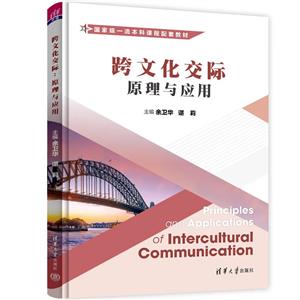-
>
鲍勃·迪伦诗歌集:1961-2012:典藏版
-
>
双城记-英文版
-
>
四级词汇词根+联想记忆法:乱序版
-
>
The secret garden
-
>
哈克贝利.费恩历险记/床头灯英语.2000词读物(英汉对照)
-
>
10000德语分类词汇联想记忆
-
>
英语词汇全书
跨文化交际:原理与应用 版权信息
- ISBN:9787302614449
- 条形码:9787302614449 ; 978-7-302-61444-9
- 装帧:一般胶版纸
- 册数:暂无
- 重量:暂无
- 所属分类:>>
跨文化交际:原理与应用 本书特色
国界的跨越,语言的异同,文化的碰撞,面对偏见歧视如何保持文化自信?国际交往中如何讲好中国故事?国家一流线上课程教学团队带你开启激动人心的跨文化交际之旅!本教材理论联系实际,将跨文化交际相关的案例分析、问题意识与理论体系有机结合,特别是在使用案例分析跨文化交际过程中遇到的相关冲突和问题时导入相关原理和理论,而绝非在讲解原理和理论时以问题来证明前者。本教材注重让学生通过团队合作的方式完成任务、解决文化冲突,促进自主性学习、过程性学习和体验式学习。
跨文化交际:原理与应用 内容简介
《跨文化交际:原理与应用》是重量一流本科课程“东方遇见西方:跨文化交际之旅”的配套教材。本教材采用全英文编写,内容涉及跨文化交际入门、言语和非言语交际、交际能力和跨文化能力、文化模式、不同社会语境下的跨文化交际、文化偏见、身份、全球化和全球公民,希望在提高学生英语水平的同时培养他们的跨文化交际能力。教材的主要特点是在引入跨文化交际原理时采用案例进行分析和讲解,提升学生的学习兴趣,培养他们的问题意识和思辨能力,使其尽可能在轻松愉快的学习过程中获得更好的学习体验和学习效果。 本教材另配有各章节习题、测试题及内容丰富的PPT 课件,读者可登录www.tsinghuaelt.com下载使用。 本教材适用于高等学校跨文化交际类课程,也可供在智慧树平台学习该门课程的学生和对跨文化交际感兴趣的相关人士使用。
跨文化交际:原理与应用 目录
Chapter 1
Brief Introduction to Intercultural Communication
1.1 Defining and Describing Culture 2
1.1.1 Two Types of Culture 2
1.1.2 Five Dimensions of Culture 3
1.1.3 Characteristics of Culture 5
1.2 Culture and Communication 9
1.2.1 Defining and Describing Communication 9
1.2.2 Relationship Between Culture and Communication 10
1.3 Defining and Describing Intercultural Communication 13
1.3.1 Definition of Intercultural Communication 13
1.3.2 Five Elements in the Communication Process 14
Chapter 2
Verbal and Nonverbal Communication
2.1 Introduction to Verbal Communication 22
2.1.1 Role of Language in Verbal Communication 23
2.1.2 Receptive and Productive Language Skills 25
2.1.3 Need for Using Bias-Free Language 26
2.1.4 Types of Verbal Communication 26
2.2 Verbal Communication Skills 29
2.2.1 Effective Verbal Communication 29
2.2.2 Examples of Verbal Communication Skills in the Workplace 29
2.2.3 7Cs of Communication 32
2.2.4 Steps to Improve Your Verbal Communication Skills in the Workplace 33
2.3 Introduction to Nonverbal Communication 36
2.3.1 Definition of Nonverbal Communication 37
2.3.2 Types and Features of Nonverbal Communication 37
2.4 Functions of Nonverbal Communication 43
2.4.1 Conveying Meaning 43
2.4.2 Regulating Conversational Flow 44
2.4.3 Affecting Relationships 45
2.4.4 Expressing Identities 49
2.5 Guidelines to Improve Nonverbal Competence 51
Chapter 3
Communicative Competence & Intercultural Competence
3.1 Communicative Competence & Intercultural Communicative
Competence 60
3.1.1 Framework for Communicative Competence 61
3.1.2 Concept of Intercultural Communicative Competence 62
3.1.3 Concept of Transcultural Competence 63
3.1.4 Skills of Multilingual Communicators 64
3.2 Communicating Under Different Cultural Contexts 65
3.2.1 Differences in Greetings 66
3.2.2 Differences in Approval and Disapproval Movements 68
3.2.3 High-Contact Culture & Low-Contact Culture 71
3.2.4 Signs Cannot Be Used Casually Abroad 73
3.3 A Recipe for Successful Intercultural Communication 75
3.3.1 A Heart Set 76
3.3.2 A Mindset 77
3.3.3 A Skill Set 78
3.3.4 Other Practical Approaches 79
3.4 Culture Shock 79
3.4.1 Five Stages of Culture Shock 79
3.4.2 Reverse Culture Shock 83
3.4.3 Transition Shock 84
Chapter 4
Cultural Patterns
4.1 A Brief Introduction to Cultural Patterns 90
4.1.1 Beliefs 91
4.1.2 Values 92
4.1.3 Norms 94
4.2 High-Context & Low-Context Cultures 96
4.2.1 High-Context Culture 96
4.2.2 Low-Context Culture 97
4.2.3 Differences Between High-Context Culture & Low-Context Culture .98
4.2.4 China—A Country in a High-Context Culture 101
4.2.5 America—A Country in a Low-Context Culture 102
4.3 Cultural Dimensions Theory 106
4.3.1 Masculinity & Femininity 107
4.3.2 High Power Distance & Low Power Distance 109
4.3.3 Collectivism & Individualism 113
4.3.4 Uncertainty Avoidance 117
4.3.5 Long-Term Orientation & Short-Term Orientation 119
4.4 Values Orientation Theory 124
4.4.1 Human-Nature Orientation 125
4.4.2 Man-Nature Orientation 126
4.4.3 Time Orientation 127
4.4.4 Activity Orientation 128
4.4.5 Relational Orientation 129
Chapter 5
Intercultural Communication in Various Social Contexts
5.1 Family and Friends 136
5.1.1 Brief Introduction to Relationship 136
5.1.2 Family Relationships 137
5.1.3 Friendships 138
5.2 Education 140
5.2.1 Relationship Between Education and Culture 140
5.2.2 Cultural Dimensions in an Educational Context 141
5.3 Economics and Business 144
5.3.1 Three Main Factors Influencing International Communication in Business 144
5.3.2 Important Tips on Doing Business Internationally 146
5.4 Principles and Rules of Intercultural Communication 148
跨文化交际:原理与应用 作者简介
余卫华,英国杜伦大学博士,教授,浙江越秀外国语学院稽山学者,英语学院院长,浙江省翻译协会副会长,中国语言教育研究会常务理事,浙江省省级一流专业(翻译)负责人。主持国家社科基金中华学术外译一项、教育部重点课题一项、一流课程一门及省市厅级课题多项。在权威或核心期刊发表学术论文40余篇,出版学术著作和教材20多部。
- >
姑妈的宝刀
姑妈的宝刀
¥11.4¥30.0 - >
史学评论
史学评论
¥18.5¥42.0 - >
苦雨斋序跋文-周作人自编集
苦雨斋序跋文-周作人自编集
¥6.9¥16.0 - >
二体千字文
二体千字文
¥16.0¥40.0 - >
李白与唐代文化
李白与唐代文化
¥9.9¥29.8 - >
经典常谈
经典常谈
¥25.9¥39.8 - >
龙榆生:词曲概论/大家小书
龙榆生:词曲概论/大家小书
¥9.1¥24.0 - >
罗庸西南联大授课录
罗庸西南联大授课录
¥21.1¥32.0
-
湖光山色(英文版)
¥15.1¥72 -
诺桑觉寺-中译经典文库-世界文学名著-第五辑
¥3.6¥12 -
无名的裘德-中译经典文库-世界文学名著-第五辑
¥7.2¥24 -
小飞侠彼得·潘(纯英文版)
¥7.5¥19.8 -
莎士比亚戏剧故事
¥5¥12.8
中国56个民族神话故事(四色)—维吾尔族卷
¥5.2¥16.2法学的历史(第4卷):法理学中卷(1996年-2003年)
¥40.3¥139.0如何是好
¥42.2¥68.0















